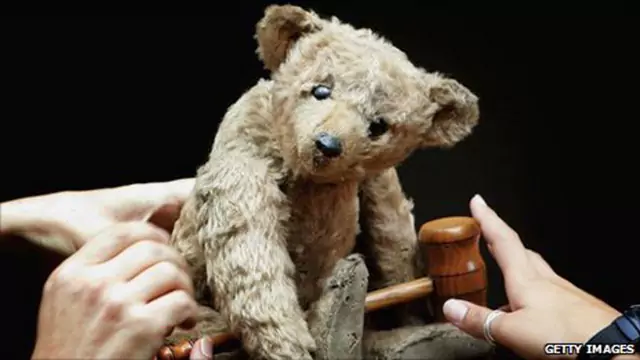1904 Steiff Teddy Bears Growler
By Frances Cronin BBC News
July 26, 2011
In 1903, 3,000 teddy bears were sent by ship from Germany to America only for them to disappear. Some claim the bears were the first ever made and would now be the most valuable in the world. So what happened to them?
In the Steiff museum, in the German town of Giengen, the mystery of the missing bears is explained to the visiting children with a tale that they were lost at sea.
The idea of shipwrecked teddy bears captures the imagination, but is it true?
The company was established by seamstress Margarete Steiff in the 19th Century. In 1880, needing a present for a nephew, she found a pattern for a toy elephant and made it from soft felt. Drawn to how soft and cuddly they were, children in the neighbourhood were soon asking for elephants too.
She started to make the elephants alongside her dressmaking business but it was her nephew Richard Steiff who came up with the idea of a toy bear.
As a student at art college in Stuttgart he used to visit the zoo and sketch the bears. At the zoo they had cross-bred brown bears with polar bears and these became the inspiration for his first life-like toy bear.
“Before the bear, children were playing with porcelain dolls, soldiers, tin toys. They were hard and cold and Richard wanted to give children a companion that they could hold,” explains Leyla Maniera, a former bear expert at Christie’s and consultant for Steiff.
Steiff’s first bear was called 55 PB. The 55 stood for its height, P stood for plush and B for beweglich, German for moveable.
55 PB was introduced to the German public at the Leipzig Toy Fair in spring 1903. But there was not much interest, says Maniera.
“There’s a wonderful story how he’s [Richard Steiff] just so fed up he’s putting all the bears back in the boxes and he’s sealing everything up when Hermann Berg comes, a buyer for Borgfeldt in New York.
“Berg is desperately miserable as he’s been trudging around the trade fair all week and he hasn’t found anything to take back to New York and he’s under instruction to bring something new back.
“He spies on Richard Steiff’s stand as he’s nailing down almost the last box and he asks Richard what’s in there? He pulls out 55 PB and Hermann Berg is captivated by him. Apparently on the spot he orders 3,000 bears – a massive order at that time.”
The premises of the Steiff business could not cope and they had to build a new factory in which to make the bears. Templates and patterns of the bears exist but none have ever turned up.
“The order was definitely made,” says Maniera, “We have samples of the boxes so we know they were boxed up and shipped.
“The archives have copies of orders right from the beginning. We do know the orders were made, they were packed and shipped, but sadly to this day we don’t know what happened to the 3,000 bears.”
So how about that theory about the bears being lost at sea? Gunther Pfieffer, author of four books about Steiff bears, does not believe it.
“The mystery first appeared in 1953 with the 50th anniversary of the teddy bear. A clever employee of the marketing department was writing a little festival book and that’s the first time this story came up.
“So I guess it was just a good marketing idea, nothing else.”
But if they were shipped, why have none ever appeared in attics or auction houses?
Manuela Fustig, from the Steiff museum, has a theory. “I think this is due to the construction of the bear. His arms and head and legs were jointed to his body with strings so this was very breakable and I think the bears have not survived.”
But she is hopeful that one could still re-appear.
“When I have guests I say to them ‘look at your home to see if there is a strange looking bear in a dark colour and send me a photo’ and I’m waiting everyday, hoping, that somebody has found a 55 PB,” says Fustig.
“He is very dark in colour – he hasn’t the cute charming look of a typical Steiff teddy bear, he has no button in his ear – he was made in 1903 and the buttons were added in 1904.
Teddy bear enthusiasts are able to buy a replica of the bear online for £399, but if you found one in your attic it would be a collector’s dream.
“If a PB 55 is discovered, he would completely crash and break all existing world records without question,” says Maniera.
“There isn’t anything more important than PB 55. The current world record is over £180,000 but he would easily break that.”
